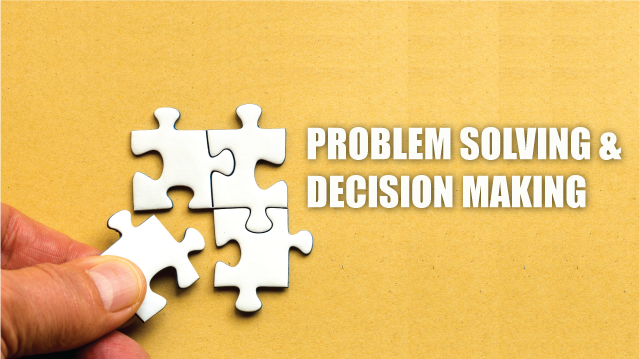


The 'Problem Solving & Decision Making' course equips participants with essential skills and techniques to identify, analyze, and solve problems effectively, as well as make sound decisions. Topics include problem identification, analysis, solution generation, decision-making models, risk management, implementation, communication, ethical considerations, and continuous improvement. The course emphasizes practical strategies for addressing challenges and driving positive outcomes in various contexts.
Overview: The Problem-Solving & Decision-Making training program is designed to equip participants with the tools and techniques necessary to tackle complex problems and make informed decisions in the workplace. This program focuses on enhancing analytical thinking, fostering creativity, and improving the overall decision-making process. It is suitable for professionals at all levels who seek to develop their problem-solving capabilities and make better decisions in their roles.
Objective:
• Enhance Analytical Skills: Develop participants’ abilities to analyze problems and identify root causes.
• Foster Creative Thinking: Encourage innovative thinking to generate effective solutions.
• Improve Decision-Making Processes: Equip participants with structured approaches to making decisions.
• Boost Confidence: Build confidence in tackling complex problems and making decisions.
• Promote Collaborative Problem-Solving: Encourage teamwork and collaboration in problem-solving and decision-making.
• Develop Critical Thinking: Enhance participants' critical thinking skills to evaluate options and outcomes.
Training Content:
1. Introduction to Problem-Solving and Decision-Making
• Importance of problem-solving and decision-making skills in the workplace
• Overview of the problem-solving and decision-making process
• Common challenges and pitfalls
2. Defining and Understanding Problems
• Identifying and defining problems clearly
• Techniques for understanding the scope and impact of problems
• Tools for gathering and analyzing relevant information
3. Root Cause Analysis
• Methods for identifying the root causes of problems (5 Whys, Fishbone Diagram)
• Differentiating between symptoms and root causes
• Techniques for verifying root causes
4. Generating Solutions
• Brainstorming techniques to generate creative solutions
• Encouraging divergent and convergent thinking
• Evaluating the feasibility and impact of potential solutions
5. Decision-Making Models and Tools
• Overview of decision-making models (Rational Model, Intuitive Model)
• Using decision-making tools (SWOT Analysis, Decision Matrix, Cost-Benefit Analysis)
• Balancing qualitative and quantitative factors in decision-making
6. Risk Assessment and Management
• Identifying and assessing risks associated with decisions
• Techniques for managing and mitigating risks
• Contingency planning and scenario analysis
7. Evaluating Options and Making Decisions
• Criteria for evaluating options
• Comparing and prioritizing alternatives
• Making informed and timely decisions
• Avoiding common decision-making biases
8. Implementing Solutions and Decisions
• Developing action plans for implementation
• Assigning roles and responsibilities
• Monitoring and adjusting implementation as needed
• Communicating decisions and solutions effectively
9. Collaborative Problem-Solving and Decision-Making
• Importance of teamwork in problem-solving
• Techniques for facilitating group problem-solving sessions
• Building consensus and managing conflicts within teams
• Leveraging diverse perspectives for better outcomes
10. Case Studies and Real-Life Scenarios
• Analyzing real-world problems and decision-making scenarios
• Interactive discussions on case studies
• Applying learned techniques to practical situations
11. Continuous Improvement and Learning
• Reflecting on problem-solving and decision-making processes
• Learning from successes and failures
• Techniques for continuous improvement
• Resources for ongoing development of problem-solving and decision-making skills
12. Personal Action Planning
• Developing a personal plan for improving problem-solving and decision-making skills
• Setting goals for applying learned techniques in the workplace
• Identifying resources and support for ongoing development
• Reviewing and adjusting plans based on feedback and experiences
Training Methods:
• Lectures and Presentations: Deliver foundational knowledge and key concepts.
• Interactive Workshops: Engage participants in practical exercises and group activities.
• Case Studies: Analyze real-life examples to illustrate problem-solving and decision-making techniques.
• Group Discussions: Facilitate sharing of experiences and collaborative learning.
• Role-Playing: Simulate scenarios to practice problem-solving and decision-making skills.
• Self-Assessments: Tools to evaluate current problem-solving and decision-making abilities.
• Feedback Sessions: Offer opportunities for peer and facilitator feedback.
Week 1: Introduction to Problem Solving and Decision Making
Week 2: Problem Identification and Definition
Week 3: Problem Analysis and Evaluation
Week 4: Generating and Evaluating Solutions
Week 5: Decision-Making Models and Processes
Week 6: Risk Management and Contingency Planning
Week 7: Implementing and Monitoring Solutions
Week 8: Communication, Ethical Considerations, and Continuous Improvement